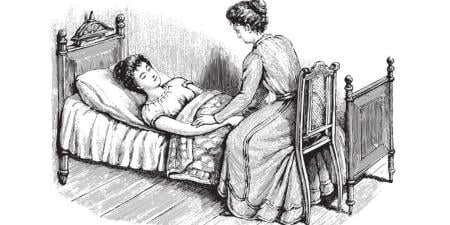To treat the rapidly growing population of people aged 65 and older, residents and medical students need to know how aging and age-associated conditions affect the autonomy and quality of life of elderly patients [1]. Old age does not always mean frailty and senility. Indeed the majority of adults aged 65 and older remain healthy even to their eighties. For some seniors, however, old age comes with disease, limited social and economic resources, and physical and mental impairments.
Most elderly patients are cared for by nongeriatricians, usually internal medicine and family medicine physicians. Thus, residents in these specialties need to know the physiologic changes associated with aging and other common geriatric syndromes [2, 3] and how those changes affect medication and treatment plans. Elder care occurs in various settings, including the patient’s home, inpatient geriatric units, postacute care units, hospice care facilities, assisted living facilities, outpatient clinics, and nursing homes. At a minimum, residents and students should participate in elder care in the settings of an outpatient clinic and nursing home to acquire the clinical geriatric skills necessary for managing common age-related syndromes such as delirium, dementia, and drug misuse. Work at an outpatient clinic and nursing home can be integrated into an existing 4-week medicine rotation. The University of Texas Medical Branch (UTMB) in Galveston currently offers a community gerontology elective during which students see patients in a nursing home, in a home-care setting, and in the clinics. More specialized knowledge of the geriatric population is gained through a 1-week compulsory rotation during the neurology clerkship. The settings for this course are outpatient clinics and the inpatient geriatric unit known as the acute care for elders (ACE) unit.
Geriatric Outpatient Clinics Rotation
By spending 1 half day per week in a general geriatrics clinic, residents and students see a range of aging patients from the relatively healthy to the frail. The experience gives them the opportunity to learn to do a comprehensive geriatric assessment (CGA), collecting information on the mental, functional, social, and biological status of older persons [4]. Residents and students then learn to use that information when planning and implementing evidence-based interventions for common geriatric syndromes such as dementia, delirium, drug misuse, depression, falls, incontinence, pressure ulcers, and functional decline.
Dementia and delirium, frequently seen in the outpatient clinic setting, adversely impact the autonomy and the decision-making capacity of seniors [4-7]. Found in as many as 40 to 50 percent of patients aged 85 or older, dementia is acquired chronic brain dysfunction that manifests as memory loss, disorientation, aphasia, and other cognitive deficits [8]. Delirium, on the other hand, is the acute onset of confusion, poor attention, drowsiness or agitation, and fluctuation in alertness level and is generally treated by addressing the underlying causes of the confusion. Both disorders can have depression as a comorbidity. By helping to manage these and other geriatric conditions, residents and students acquire valuable skills that are key to effective interprofessional working relationships with others on the CGA team: nurses, social workers, physical and occupational therapists, pharmacists, and dietitians.
Nursing Home Rotations
During their 1-day-a-week rotation in a nursing home, learners meet a patient population that is generally more frail and disabled in a non-community-based setting. Here they gain additional knowledge and skill in managing disorders common in the elderly and observe how the members of the CGA team work together in this environment.
A typical nursing home has two groups of elderly residents—the permanent and the temporary. The permanent, long-term care residents (LTC) live there because they are incapable of independent living. The nursing home staff provides support for their basic activities of daily living such as ambulation, bathing, using the toilet, and eating. The cost of long-term care is covered by Medicaid or private funding. Patients with dementia account for about half of all long-term care admissions [9].
The temporary, short-term residents are usually at the nursing home for physical rehabilitation, wound care, administration of intravenous antibiotics, or speech therapy. This section of the nursing home is also known as the skilled nursing facility (SNF) or skilled nursing unit (SNU). The needs of SNF residents vary. Most are there to receive physical and occupational therapy (PT/OT) aimed at restoring and preserving their mobility and function following a stroke, for example, or hip fracture repair. The cost of an elderly patient’s stay in SNF is fully covered by Medicare for up to 20 days per benefit period [10].
Drug Misuse
Polypharmacy is a real concern for the geriatric population, regardless of the setting [11-14]. Polypharmacy, literally “many drugs,” occurs when a patient is prescribed—and takes—more than three medications. Polypharmacy may be clinically necessary in certain situations, e.g., congestive heart failure; in other circumstances, it reflects unnecessary or inappropriate prescription use. This often happens when clinicians prescribe new medications to treat side effects of other medications, creating a phenomenon known as a prescribing cascade [13]. Physicians-in-training need to know that the risk of drug toxicity rises as patients take more prescribed and over-the-counter medications and that the highest prevalence of polypharmacy is in adults aged 65 years or older. In one large community-based study, for example, 12 percent of older women took 10 or more drugs, while 23 percent took 5 or more [15]. Drug misuse is particularly worrisome in this population because older adults metabolize and eliminate drugs more slowly than younger adults due to decreased renal and hepatic functions. Slow clearance and multiple drug use increase the risk of harmful interactions, which are a major cause of emergency room visits and hospitalizations [16].
Most drugs need to be started at low doses and titrated up slowly in elderly patients, and any new symptom in an older person can be due to an adverse drug event. Residents should become familiar with the Beers list of drugs that are potentially inappropriate for use in older people [12], for example, diphenhydramine. Chronic use of diphenhydramine for insomnia can contribute to delirium, dementia, falls, incontinence, unsteady gait, and constipation.
Summary
The training in nursing homes and clinics described above constitutes a bare minimum of geriatric knowledge and skills needed by students and residents in internal medicine and family medicine. These lessons can be integrated into undergraduate medical school curriculum without changing current curricular structure by infusing geriatric themes and content into existing courses and clerkships. An example of a successful infusion was described by Newell and colleagues in the Journal of Gerontology and Geriatrics Education [17]. Effective curricular infusion into courses and clerkships requires institutional financial commitment and interdepartmental collaboration across a school of medicine.
References
-
Federal Interagency Forum on Aging-Related Statistics. Life expectancy. Accessed May 14, 2008.
-
Raji MA, Goodwin JS. Biology of aging. In: Calhoun K, Eibling DE, eds. Geriatric Otolaryngology. New York, NY: Taylor & Francis Group; 2006:17-23.
- Inouye SK, Studenski S, Tinetti M, Kuchel GA. Geriatric syndromes: clinical, research, and policy implications of a core geriatric concept. J Am Geriatr Soc. 2007;55(5):780-791.
-
Raji MA. Geriatric assessment. In: Markides KS, ed. Encyclopedia of Health and Aging. Thousand Oaks, CA: Sage Publications; 2006:237-240.
- Cummings JL. Alzheimer's disease. N Engl J Med. 2004;351(1):56-67.
-
Folstein MF, Folstein SE, McHugh PR. " Mini-mental state." A practical method for grading the cognitive state of patients for the clinician. J Psychiatr Res. 1975;12(3):189-198.
- Young J, Inouye SK. Delirium in older people. BMJ. 2007;334(7598):842-846.
- Evans DA, Funkenstein HH, Albert MS, et al. Prevalence of Alzheimer's disease in a community population of older persons. Higher than previously reported. JAMA. 1989;262(18):2551-2556.
- Magaziner J, German P, Zimmerman SI, et al. The prevalence of dementia in a statewide sample of new nursing home admissions aged 65 and older: diagnosis by expert panel. Epidemiology of Dementia in Nursing Homes Research Group. Gerontologist. 2000;40(6):663-672.
-
National Institute on Aging. Nursing Homes: Making the Right Choice. Washington, DC: US Department of Health and Human Services; 2008. http://www.niapublications.org/agepages/PDFs/Nursing_Homes_Making_the_Right_Choice2-07.pdf. Accessed on April 24, 2008.
-
Raji MA. Polypharmacy. In: Markides KS, ed. Encyclopedia of Health and Aging. Thousand Oaks, CA: Sage Publications; 2006:468-470.
- Fick DM, Cooper JW, Wade WE, Waller JL, Maclean JR, Beers MH. Updating the Beers criteria for potentially inappropriate medication use in older adults: results of a US consensus panel of experts. Arch Intern Med. 2003;163(22):2716-2724.
- Rochon PA, Gurwitz JH. Optimizing drug treatment for elderly people: the prescribing cascade. B MJ. 1997;315(7115):1096-1099.
- Raji MA, Ostir GV, Markides KS, Espino DV, Goodwin JS. Potentially inappropriate medication use by elderly Mexican Americans. Ann Pharmacother. 2003;37(9):1197-1202.
- Kaufman DW, Kelly JP, Rosenberg L, Anderson TE, Mitchell AA. Recent patterns of medication use in the ambulatory adult population of the United States: the Slone survey. JAMA. 2002;287(3):337-344.
- Hanlon JT, Schmader KE, Kornkowski MJ, et al. Adverse drug events in high risk older outpatients. J Am Geriatr Soc. 1997;45(8):945-948.
- Newell DA, Raji M, Lieberman S, Beach RE. Integrating geriatric content into a medical school curriculum: description of a successful model. Gerontol Geriatr Educ. 2004;25(2):15-32.



